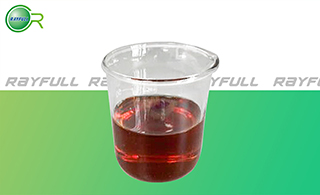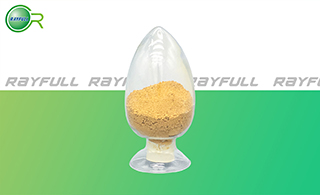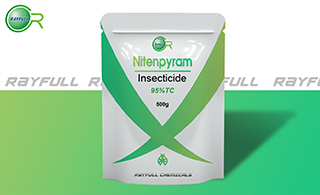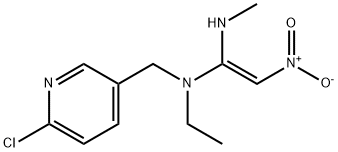Nitenpyram
    烯啶虫胺 烯啶虫胺
Introduction: Nitenpyram is an insecticide used in agriculture and veterinary medicine to kill of external pests, like fleas. The compound is a neurotoxin belongs to the class of neonicotinoids, which works by blocking neural signaling of the central nervous system in specifically insects. It does so by binding irreversibly to the Nicotinic acetylcholine receptor (nACHr), causing a stop of the flow of ions in the postsynaptic membrane of neurons, leading to paralysis and death. Being highly selective towards certain variation of the nACHr, namely the types insects possess, nitenpyram has been seen extensible use in targeted insecticide applications, such as pet treatment and agriculture.
Common name: Nitenpyram
Another name: (E)-Nitenpyram; (E)-N-((6-Chloropyridin-3-yl)methyl)-N-ethyl- N'-methyl-2-nitroethene-1,1-diamine; Niterndipoine; Bestguard; etc.
Chemical name: (E)-N-(6-chloro-3-pyridylmethyl)-N-ethyl-N'-methyl-2-nitrovinylidenediamine
Empirical formula: C11H15ClN4O2
Structural formula:

Mol. Weight: 270.72 g/mol
CAS No.: 150824-47-8
Specifications
Leading Nitenpyram supplier
Nitenpyram 95% TC
Nitenpyram 96% TC
Nitenpyram 60% WP
Nitenpyram 50% SP&GR
Nitenpyram 25% SP
Nitenpyram 10% SL
Packing:
BULK PACKING
Powder: 25kg/Bag, 25kg/Drum, 50kg/Drum etc.
Liquid: 200L/Drum, 20L/Drum, 10L/Drum etc.
SMALL PACKING
Powder: 1kg/Alu bag, 500g/Alu bag, 200g/Alu bag, 100g/Alu bag, 50g/Alu bag, 15g/Alu bag etc.
Liquid: 5L/Drum, 1L/Bottle, 500ml/Bottle, 250ml/Bottle, 100ml/Bottle, 50ml/Bottle etc.
Customerized packing label
Nitenpyram FAO standard
Professional registration
HAZARDS IDENTIFICATION
Hazard statement(s)
H302 (100%): Harmful if swallowed.
H315 (100%): Causes skin irritation.
H319 (100%): Causes serious eye irritation.
H335 (100%): May cause respiratory irritation.
Precautionary statement(s)
P261: Avoid breathing dust/fume/gas/mist/vapors/spray.
P264: Wash ... thoroughly after handling.
P270: Do not eat, drink or smoke when using this product.
P280: Wear protective gloves/protective clothing/eye protection/face protection.
P301+P312: IF SWALLOWED: call a POISON CENTER/doctor/... IF you feel unwell.
P302+P352: IF ON SKIN: wash with plenty of water.
P304+P340: IF INHALED: Remove person to fresh air and keep comfortable for breathing.
P305+P351+P338: IF IN EYES: Rinse cautiously with water for several minutes. Remove contact lenses if present and easy to do - continue rinsing.
P312: Call a POISON CENTER or doctor/... if you feel unwell.
P321: Specific treatment (see ... on this label).
P332+P313: IF SKIN irritation occurs: Get medical advice/attention.
P362: Take off contaminated clothing.
P405: Store locked up.
P501: Dispose of contents/container to.
Supplemental Hazard Statements: none.
MAMMALIAN TOXICOLOGY
Acute toxicity: 1) Acute oral LD50 for rats is 1575 mg/kg. 2) Acute dermal LD50 for rats is >2000 mg/kg. 3) Acute inhalation toxicity LC50 (4 h) for rats is 5.8 mg/L. 4) Skin irritation: Non-irritating to skin (rabbits). 5) Eye irritation: Slightly irritating to eyes (rabbits). 6) Skin sensitization for guinea pig: Non-sensitizer.
NOEL: (2 y) for male rats 129 mg/kg/day, female rats 53.7 mg/kg/day; (1 y) for male and female dogs 60 mg/kg/day. Other Not carcinogenic. Not genotoxic.
Classification:
WHO Classification: II (Moderately hazardous)
EC Risk Classification: Xn - Harmful: R22; Xi - Irritant: R36, R37, R38
ECOTOXICOLOGY
Effect on birds: Acute oral LD50 (8 d) for Mallard is 1124 mg/kg. Effect on fish: Acute LC50 (96 h) for Rainbow trout is 10 mg/l. Effects on aquatic invertebrates: Acute EC50 (48 h) for Daphnia magna is 10000 mg/l. Effects on algae: Acute 72 hour EC50 for Pseudokirchneriella subcapitata is 26 mg/l. Effects on bees: acute 48 hour LD50 is 0.138 μg/bee. Effects on earthworms: Acute 14 day LC50 is 32.2 mg/kg.
ENVIRONMENTAL FATE
Nitenpyram half-life in soil is short, 1 to 15 days depending on the type of soils and other conditions. It does not hydrolyze in acid or neutral water, but breaks down in alkaline water (half-life ~3 days). Nitenpyram does not bioaccumulate.
Usage: Nitenpyram was introduced by Takeda Chemical Industries Ltd (now Sumitomo Chemical Takeda Agro Company Ltd). It is an insecticide used mainly to kill external parasites in livestock and domestic pets buts also used to control sucking insects on rice and in greenhouse crops.
Application: Biochemistry Agonist of the nicotinic acetylcholine receptor, affecting cholinergic transmissions in the insect central nervous system. Mode of action Systemic insecticide with translaminar activity and with contact and stomach action. Uses Control of aphids, thrips, leafhoppers, whitefly, and other sucking insects on rice and glasshouse crops. On rice, applied at 15-75 g/ha (foliar), 75-100 g/ha (dust) or 300-400 g/ha (soil treatment). Also for control of fleas on cats and dogs.
| 






